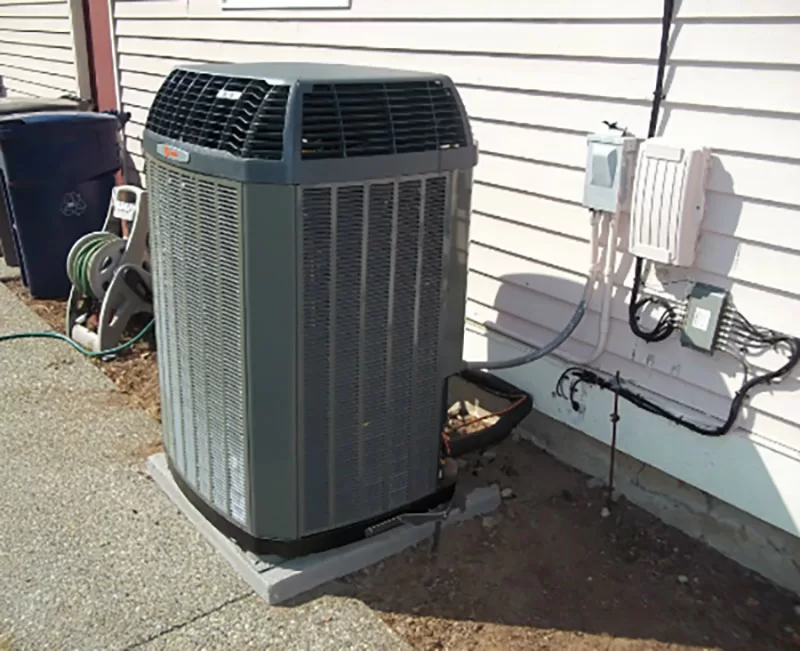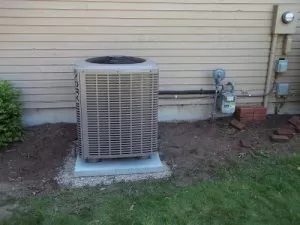Nobody likes playing hot and cold roulette with the temperature in their home. But that’s exactly what happens when your heat pump gets stubborn about switching between heating and cooling modes. You crank it one way, but it keeps blowing the opposite!
This blog breaks down why heat pumps sometimes pull this trick on us. First, we’ll do a quick recap on how these HVAC systems are supposed to work – moving heat out in summer, but reversing to bring it inside for warmth over winter. Simple in theory, but with various components involved.
From there, we’ll explore some of the typical troublemakers that can interfere with smooth mode changing. Electrical gremlin? Refrigerant issues? Thermostat on the fritz? We’ll go through the likely suspects one by one so you know what to check.
Then we’ll cover easy troubleshooting steps to get your heating and cooling system back up and running. Plus a few maintenance pointers to prevent this whole fiasco next time around. By understanding what’s behind a heat pump’s hot/cold reluctance to follow orders, you can regain control of your home’s comfort levels all year.

Overview of Heat Pump Operation
Heat pumps are pretty simple systems – they just move heat from one place to another. But that basic transfer is what allows them to serve double-duty as both heating and cooling units for your home.
The key components are the indoor air handler unit and outdoor condensing unit, connected by copper refrigerant lines. It’s kind of like an air conditioner that can also run in reverse.
For cooling, the outdoor unit’s compressor circulates refrigerant that absorbs heat from inside your house. The refrigerant carries this captured heat outside, where it’s expelled into the air around the condensing unit. Fans blow hot air over the coil fins to release the heat energy.
To switch to heating mode, the whole refrigerant flow reverses using a nifty little device called a reversing valve. Now the outdoor condenser coil pulls heat energy out of the air (yes, even cold winter air has some heat!). The refrigerant carries this thermal energy indoors to the air handler. Blown air cycles over the warm coils and distributes heated air through your duct system.
So whether you need heating or cooling, the heat pump is basically just shuffling heat around rather than generating it from scratch. That’s what makes it so efficient compared to old-school furnaces and AC units working separately.
Of course, there are various electronic controls, sensors, motors, and other components involved too. We’ll get into some of those parts and how they can cause hiccups in the mode switching process next.
Common Reasons for Mode Switch Failure
Even though heat pumps seem straightforward, there’s actually a lot that can potentially get bungled when trying to switch between heating and cooling operations. From tiny thermostat snafus to refrigerant leaks, any number of issues can gum up the works. Let’s look at some of the most frequent culprits:
Thermostat Issues
This is literally the control center for your heating and cooling system. If the thermostat settings are inputted incorrectly or it has wiring problems, it may send the wrong signals or none at all regarding which mode you want. An old thermostat with drained batteries can totally fail to communicate with the heat pump. Even a thermostat located in a poor spot that doesn’t reflect accurate temperatures can cause confusion about whether heating or cooling is needed.
Reversing Valve Problems
As we mentioned, this key component is what actually reverses the refrigerant flow direction to switch the heat pump between heating and cooling modes. If this reversing valve gets stuck due to leaks, electrical issues, or contaminants in the lines, your system will get trapped only bringing heat in or expelling it out. That reversing action is critical for the system to change modes successfully.
Low Refrigerant Levels
Refrigerant is the lifeblood allowing the heat transfer to happen. If levels get too low due to leaks, there just isn’t enough refrigerant circulating to effectively move heat where it needs to go, whether for heating or cooling purposes. You may notice the air not feeling very warm or cool regardless of mode. Recharging the refrigerant can potentially allow the heat pump to remember how to switch modes again.
Electrical Issues
The heat pump relies on electrical components and wiring to control and communicate all the mode switching functions. If there are any gremlinish issues happening with circuit boards, relays, sensors or just janky wiring connections, it can totally disrupt the signals telling the different parts how and when to switch operations.
These electrical snafus could happen anywhere from the compressor and reversing valve controls to the fan motor operations. Basically, if the electrical synapses aren’t firing right, the whole mode change process gets scrambled.
Outdoor Unit Complications
For the heat pump’s outdoor condensing unit, a few different gunk-ups can make it get stuck in one mode or another. If the fan can’t properly circulate air over the coil fins when in cooling mode, it won’t effectively expel hot refrigerant. Or the unit might get overwhelmed by exterior build-up, like dirt, leaves or even a critter taking up residence and blocking crucial airflow. Either of those could prevent reliable switches to cooling mode.
Defrost Control Issues
Here’s one specific to heating mode operations. To absorb heat energy from the outside air, the outdoor coil needs to stay clear of ice and frost buildup or it gets insulated. So there are defrost controls and sensors that periodically initiate a reverse defrost cycle to melt any accumulation away. But if that defrost mode gets glitchy and can’t activate when needed, the coils can eventually freeze over entirely. An ice-caked outdoor unit will then struggle to continue running in heating mode, let alone switch over.
Ductwork Problems
It might seem weird, but ductwork issues can actually make it harder for a heat pump to change between heating and cooling modes properly. If you’ve got leaks, tears, or disconnections in the ductwork, it messes with the airflow and pressure through the system.
That ricocheting air can confuse the heat pump about whether it’s successfully moving conditioned air where it needs to go for heating or cooling. Ductwork is the delivery pathway, so any blockages or escapes create complications. Sealing up leaks may be all it takes to get smooth mode switching again.
Control Board Failures
The brains of the heat pump operations are those circuit boards and electronic controls. If one of those main control boards craps out due to an electrical surge, moisture damage, or simply being old and fried, it can totally hamper the heat pump’s ability to switch modes as commanded. The control board is like the master computer – if it goes haywire or loses its programming, it can’t properly direct all the supporting components to change from heating to cooling and back. A complete control board replacement may be needed.
Age and Wear
Like any machine with tons of moving parts, heat pumps simply get wear and tear over years of constant use. Electrical connections can loosen, metals and components can corrode, parts can get misaligned – all sorts of physical deterioration that creates friction in the mode changing process.
Older systems are more prone to having one or multiple small failures making mode switching harder. Performing regular maintenance helps slow that gradual breakdown. But eventually, every heat pump will get too old and clunky to keep swapping modes reliably. At that point, replacing it is cheaper than overhauling everything.
Troubleshooting Steps
Alright, so now you’ve got the rundown on why heat pumps can develop a stubborn streak about switching between heating and cooling modes. Time to troubleshoot and hopefully straighten out this temperamental HVAC system!
The first step is to do some simple checks and process of elimination to identify the potential culprit. Don’t just assume it’s one particular issue. Run through the different possibilities systematically.
Start at the thermostat – make sure it’s set to the correct mode you want (heating or cooling) and that the fan is set to “auto” rather than “on.” Check the batteries and confirm temperatures are reading accurately by comparing to another thermometer. Thermostat miscommunications are one of the easier things to rule out or fix.
From there, head outside and inspect the condenser unit. Clear away any obstructive yard debris, plant overgrowth, ice/frost buildup, etc. that could be blocking airflow. While you’re out there, also listen for any abnormal sounds from the fans or compressor that might indicate an issue.
If those easy physical checks don’t reveal any obvious problems, you’ll need to step through some of the electrical and component evaluations. Cautiously inspect wiring connections, checking for frays, burns, or looseness that could interrupt the flow.
Test out whether the reversing valve is actually shifting between heating and cooling demand. You may be able to give it a gentle nudge to check for sticking. Just be careful, as you don’t want to break anything!
The same general process applies to examining the run capacitors, defrost controls, control boards, and other key bits. Methodical testing with a multimeter can detect any electrical shorts or failures.
If you have the equipment, you can check refrigerant levels too, and look for signs of leaks. Lower than normal refrigerant charge could explain why the system can’t switch modes effectively.
For the ductwork, you can perform airflow tests and physical inspections inside the system looking for clogs, breaks or backups in the path.
Basically, you’ll need to get hands-on and have some HVAC system know-how to troubleshoot all the possibilities. Writing down your findings each step helps systematically rule things out. If you can’t pinpoint the issue yourself, it’s time to call in a professional heat pump technician for diagnosis and repairs.
Preventive Maintenance Tips
Once you’ve got your heat pump’s hot/cold identity crisis sorted out, it’s smart to stay on top of some simple preventive maintenance. A little upkeep goes a long way in preventing this whole mode switching fiasco from happening again.
At the top of the list: change those air filters! This is something homeowners often overlook, but dirty clogged filters make the whole system work harder. That added strain makes components more prone to failure when trying to switch modes. Aim to swap out filters every 1-3 months during peak heating and cooling seasons.
Twice a year – say when changing the clocks for daylight savings – do a reasonably thorough inspection of the outdoor condensing unit. Clear away any leaves, dirt, bent fins, you name it that could restrict airflow. Give the coils a gentle rinse if they’re grimy. Check that the unit is level and hasn’t settled into the ground over time. Airflow is critical for transferring heat.
While you’re out there, keep an ear out for any weird noises from the fans or compressor that could indicate an issue brewing. Don’t just assume it’s normal heat pump groaning!
Indoors, that same biannual checkup should include inspecting ductwork for any leaks, tears or disconnections where conditioned air could be escaping. Seal them up with metallic tape or caulking. You’d be surprised how much energy is wasted through duct leakage.
Once a year, it’s wise to have an HVAC professional give the whole heat pump system a more thorough once-over. They can do electrical testing, check refrigerant levels, and test operating pressures and temperatures to spot anything going awry. Catching little issues early prevents them from turning into costly breakdowns.
These simple tasks to keep your heat pump clean and maintained go a long way. Don’t let a year’s worth of neglect turn into an expensive repair – or whole system replacement – just because the heating and cooling functions got all scrambled from lack of care.
Keep Your Heat Pump Switching Smoothly with BelRed’s Maintenance Services
Keeping up with routine heat pump maintenance is essential for avoiding frustrating issues like the system getting stuck in one mode. But we get it – there’s already enough on your home upkeep plate. Why not let the pros at BelRed take that preventive maintenance off your hands?
With BelRed’s team of certified HVAC experts, you can rest easy knowing your heat pump will keep swapping between heating and cooling as needed, year after year. Our technicians follow best practices for thorough system inspections, cleanings, electrical testing and more. We’ll spot and fix any little gremlins before they turn into costly breakdowns.
BelRed doesn’t just install top-quality heating and cooling equipment – we provide total home comfort solutions focused on safety, efficiency, and your peace of mind. Our people make the difference through extensive training, the right tools, and a customer-first approach.
Don’t get caught playing hot and cold roulette again next season. Keep your heat pump running smoothly no matter the temperature outside by scheduling a maintenance visit today. Call BelRed at (855) 345-6161 to book an appointment with one of our heating and cooling experts. Easily avoid this cyclical switching headache!







